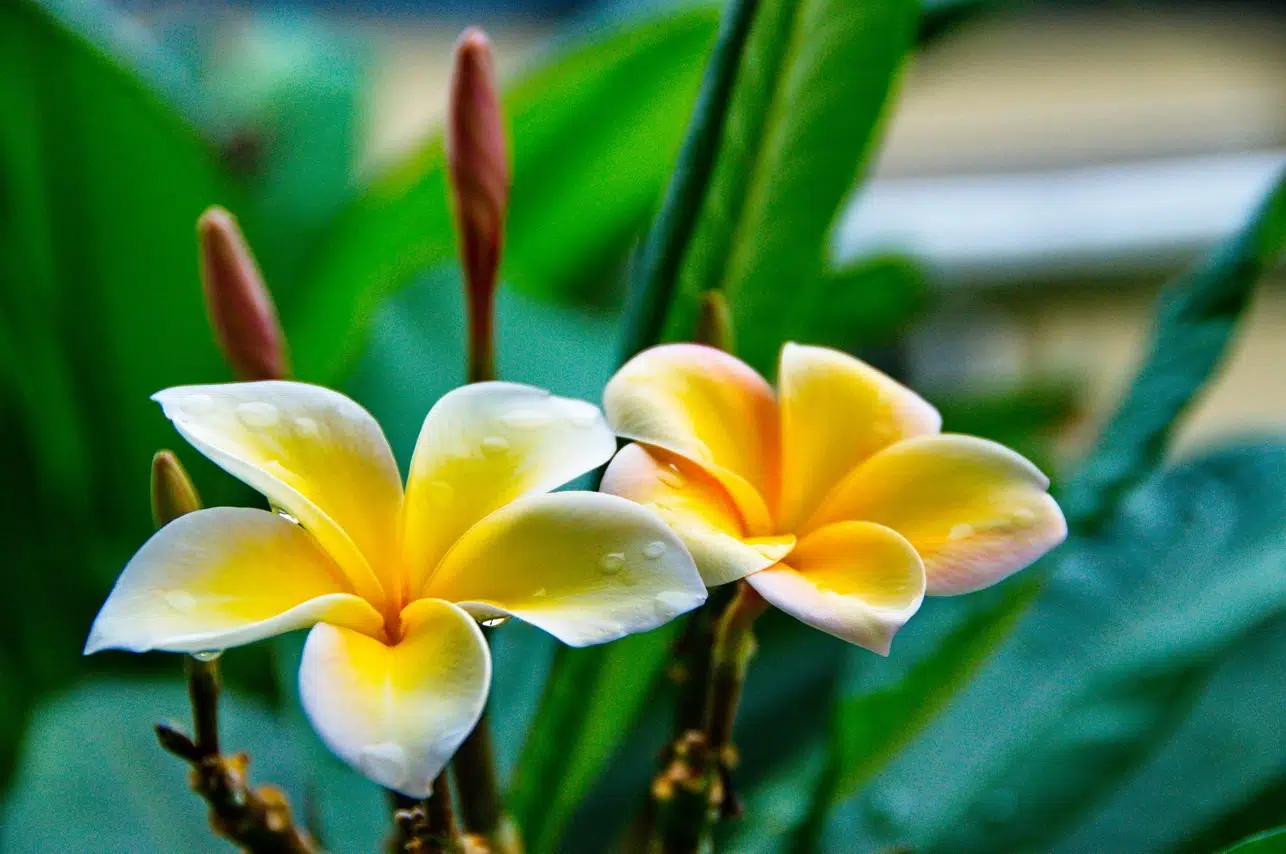
Sooner or later you might run into problems and this last chapter in the series I hope will help you to solve most of them. Plumeria problems anyway. I will use a Q&A structure in the chronological order you might experience problems on your way from cutting to flowering.
My planted Plumeria cutting doesn’t seem to be growing. I see no new leaves coming. What can I do?
Most probably you just need patience. Some cuttings can take longer to root (especially dark red and evergreen varieties). Up to 2 months is normal. Try to provide more bottom heat. Check even the next question to make sure it is not the case.
My planted Plumeria cutting is not growing and the stem base feels squashy if I slightly squeeze it between fingertips.
Some shriveling and desiccation is ok during rooting, but if it feels squashy, it is unfortunately a sign of rot. Dig it up and make a new cut above the soft part. Cut until you see healthy wood with milky sap. Let it callus and plant again. Make sure to bottom heat the planter.
More on stem root at Plumeria101.com
Black spots appear on my Plumeria leaf stalks, midribs or on the branch tips. Should I do something?
This is a sign of Black Tip Fungus which most often strike plants growing outside in wet and cold conditions. Not as common in controlled indoors environment. If you see black spots on you plants, stop water spraying, remove all affected leaves and make sure it receives sun and warm. Treat the soil with a fungicide solution and spray it on the leaves as well.
If the growing tip is smitten, the disease will most probably stop in warmer and drier conditions and the black part will shrivel and eventually fall of. If it continues spreading down the stem you should cut it under the affected part until you see healthy wood with white sap. In both cases new growing tips will evolve within a month coming out from old leaf stalk bases.
More on Black Tip Fungus at Plumeria101.com
My Plumeria has yellowing areas on the topside of the leaves and orange pustules on the undersides.
Rust Fungus can affect many plants, including Plumeria. On the infected plants you will see powdery pustules of yellow, orange or rusty-brown color. Remove all the leaves on the affected plant(s) and spray the soil and the stem with a fungicide solution.
More on Rust Fungus at Plumeria101.com
I see tiny webs on the leaves and pale, speckled areas there.
Spider mites are unfortunately common seasonal dwellers on indoors plants. Sucking plant’s sap they can severely damage and stunt Plumeria. Spider mites thrive in dry conditions. The most efficient way to fight them is preventing their appearance by regular water spraying or having an air humidifier. When they are already there bring the affected plant to the shower and high pressure shower then all the leaves trying to wash off all the mites, their webs and eggs.
If this doesn’t help and spider mites return you can consider buying and releasing on your plants so called predatory mites. They are insects of about the same size as spider mites, which they are preying on. It will take predatory mites a couple of weeks to establish themselves on the plants and you can help them out by additional water spraying. Contrary to the bad guys they love humidity.
When established they will hunt down and eat all the spider mites, their larvae and eggs. When there is no food left the good guys will die or in best case will go hibernating waiting for the next outbreak of spider mites.
There is some sticky substance on leaves and white, woolly masses on the leaves underside. What is it?
Mealybugs create copious amounts of honeydew which make plant parts and areas around it sticky. They are serious pests sucking sap and can cause leaves growing warped and miss-shaped and will stunt the plant. Blast all your plants in shower and spray the leaves with neem oil. Check even under lips of pots and trays and its undersides as mealybugs like to hide there.
More on Mealybugs at Plumeria101.com
There is some sticky substance on Plumeria leaves and small yellowish to dark brown oval to circular shells attached to the leaves and midribs.
Those are scale insects sucking plant’s juices and causing it to stunt and build ill formed leaves. Use cotton pads with some weak soap solution to remove them from leaves and spray with neem oil than.
More on scale insects at Plumeria101.com
In general, the most common way of acquiring spider mites, mealybugs and scale insects is purchasing an infested plant. Always check your new arrivals before you introduce them to the rest of your plants.
Leaves on my Plumeria are growing misshaped. What is wrong?
Deformed leaves are a sign of stress. It can be caused by insects’ infestation, by root system damage or even just by relocating plant to a new location. If no insects are found and new leaves continue to grow ill formed consider replanting.
My Plumeria has stopped growing and loosing leaves. What is going on?
This is normal with deciduous varieties when days are getting shorter and the dormancy period gets triggered. Your options here are to prepare the plant for winter storage or to provide it artificial light. If yellowing and leaves’ drop happens during the growing season that might be a sign of over fertilizing or soil exhaustion. Try to flush the soil thoroughly in a shower to dissolve the salt depositions. If new leaves are not growing, repot the plant.
I have a flower bud coming, but after a month of growing it appears to be “bold” without any flowers. What is it?
Plumeria can do this sometimes. It can push a so called false inflorescence, which will not bear any flowers. The tip will branch anyway and all you can do is to wait another growing season.
Flowers on an inflorescence are falling off without opening. What can I do?
Make sure the plant is in a warm, sunny spot or put an artificial light 5-10 in (10-25 cm) above the inflorescence. Read more about artificial light in the previous post.
My Plumeria became too large for my apartment. Can I prune it?
Yes, indoors Plumeria can be pruned any time of the year and you can cut it down rather radically. So far you leave at least some old leaf bases under the cut surface in about a month or sooner you will see new branches growing from there. You can expect 1-4 new branches replacing one cut.
I will be traveling away and cannot water my Plumeria. What can I do?
If you are going away for a short time try to arrange watering with your friends or neighbors leaving them instructions not to over water it. For longer absence Plumeria’s natural ability to survive dry seasons will come handy. Strip down the leaves and put the pot away from the sun and it can wait for you for months.
And with that I finish my Plumeria growing indoors series. Thank you for reading! Aloha!
Other posts in this series:
Part 1: Introduction to Plumeria.
Part 2: Closer look. Plumeria cultivars. True or fake on eBay?
Part 3: How to start your own Plumeria indoors.
Part 4: Plumeria care and flowering indoors.
Part 5: Plumeria problem-solving (this post).
Add your email address below and I’ll let you know, when next post is out!



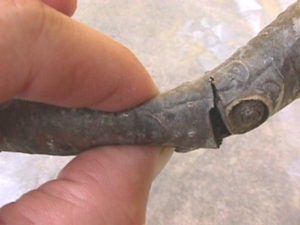
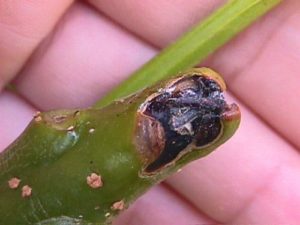
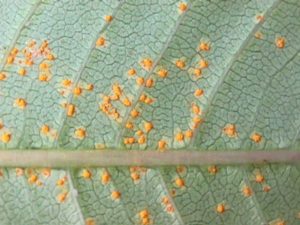
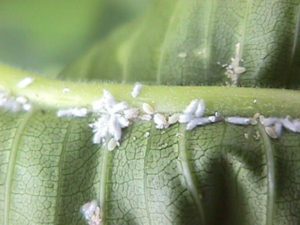
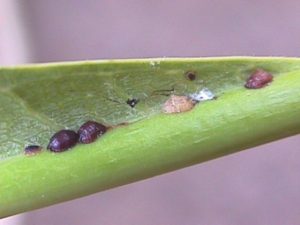
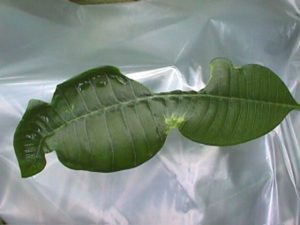
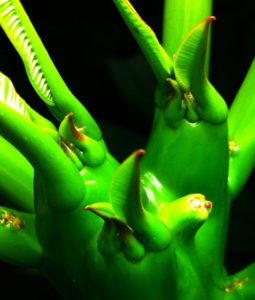
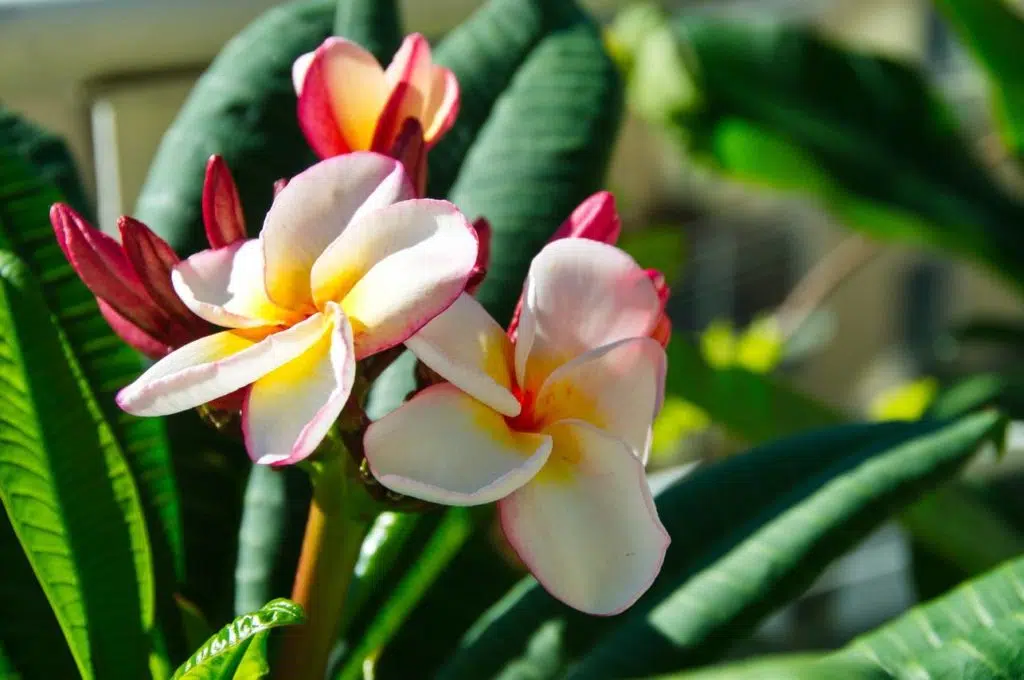


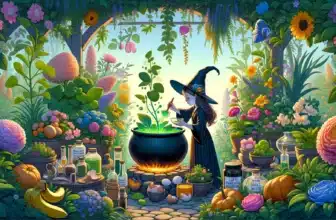
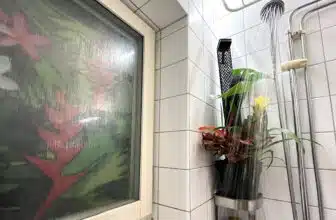
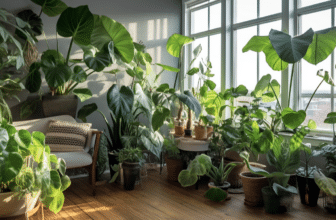
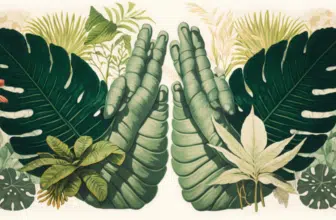

My tree is about 4 feet tall and has 2 branches. It seems to be happy. I live in Missouri and it has always been an indoor plant. I have read pretty much all the information on it yet can’t find the information I need. It has never dropped all its leaves. I am concerned about tiny white spots on the leaves. There are no bugs or rust on her. What are they and what do I need to do ??
Hello, I have to add my own response to this comment; I live in the East Midlands of the UK and have 5 Plumerias growing in a west-facing window, These are about a foot high. There are also 7 smaller plumerias in 1 trough-pot… my plumerias are exhibiting the same issue: tiny white/cream flecks on the upper side of the leaves, but absolutely clean and pest-free on the underside. Absolutely no problems with any pest at all. I seem to remember reading somewhere that this is a sign that the plant is being over-watered and cannot transpire the water quickly enough through its leaves, so the leaf pores are being damaged, particularly if tap water is used… However, I cannot now find this item of information, no matter what I Google! Also, I am very cautious with watering (I use rain water from my water-butt) and have a very good free-draining compost, so I’m very puzzled as to what is happening!
So it has dropped all the leaves and it were white spots on them. Is that correct? You didn’t happen to take any photos of the spots? How long did you have that tree? What light does it get now? How often do you water it?
Hi Alex, I need help with two of my plumeria trees. Is there a way I can send you pictures of them so you can help? One of them is squishy but not dark but is wilting. The other I cut to the main trunk about 12 inches bc it had squishy branches and I wanted to cut before it spread but not sure if this was the right thing to do. Please help
Hi Kat,
You find my email address down in the footer here, where you can send your pics.
In general, squishy stems means the roots can’t sustain the plant. It can be many reasons for this. So let me know your growing conditions like location, day/night temperatures, what kind of pot/container, soil, watering.
I have a smaller dwarf plumeria that is not supposed to loose leaves in the winter. This is our first winter for it. I am keeping it inside near a east facing window that has pretty good light. I have some browning on the tops of the leaves that are pretty dry on the tops. I don’t see any thing on the bottom. it does seem that we have lost a few leaves over this winter that eventually dry out from this. not sure if this could be normal winter behavior or if there is something else to be worried about. pictures are here: https://goo.gl/photos/1rbe4H1q4VBx9VJb9
I would love any suggestions
Dear David, I apologise for the late answer. Your comment was wrongly labelled as spam and I just noticed it. As for your Plumeria, unfortunately it looks like damage either by spider mites (do you see any tiny webs on the margins above or under the leaves?) or by thrips.
thanks, for the response – I don’t see any webs around the leaves. Looking at images for thrips damage, I don’t see any of the bugs that are generally shown with those, but it sounds like they are pretty small so maybe missing them. would it be a good idea to spray with an insecticide just to be safe?
I added a grow light recently and we are starting to get new growth, so would want to get on top of this before it gets worse.
thanks
Thrips are indeed hard to spot as they are tiny. I posted a short video for you here: https://www.youtube.com/watch?v=8LnEvpWFZIE. I deployed insects called Orius hunting thrips. The fly-like one in the video is the good guy, the tiny larvae-like one is thrips. It got away on the video, but not for long :)
Hi, Your plants are so beautiful and this is inspiring me. I’ve watched some of your videos. Can you tell me what rooting hormone you recommend for Plumeria cuttings? Also, I was given a few cuttings and put them in water. Should I dry them out for a week and then put the rooting hormone? There are so many different suggestions online but I would like your advice. Many thanks!
Hi Sunita,
Plumeria can be water rooted, but it requires constantly warm water and if you root it you will most probably damage young roots when planting. You’ll find all my recommendations for starting cuttings here: https://tropicsathome.com/start-plumeria-indoors-containers/
As for hormone, here in Sweden we have only one type available for order. In your country you probably have something completely different. Any well known brand should work. Good luck! Aloha! :)
Hello! Sorry if I am late to ask this.
Is it possible to grow my mini Plumeria indoors by the window without direct sunlight?
I live in Malaysia where the temperatures are on average 24-35 Celsius all year, but my window does not receive DIRECT sunlight. It has only quite limited sunlight because it’s blocked by other stuff. What should I do? Please advice, thank you ;)
I have a question. I have a 2 year old cutting that I brought back from Hawaii. Every year when I bring it inside it looses its leaves, and I know that is typical. The tips, and down the stem about 3 inches it appears to be shriveled. It did this last year as well. Is it getting too much water, not enough? It’s still firm, and not mushy. I’m just not sure what to do, or if anything is wrong at all.
Hi Jon, shrivelling can mean both too little water and also if roots dye because of overwatering and cannot supply the plant. However, if they previously restored from this it probably means too little water. You can try to give some more, but just a little bit.
Hello, i was Wondering if you had an ideal soil temperature that you like for your plumerias for blooming indoors.
Hi Andrew, the soil temperature should be not below 22-24C (71-75F). Make sure it’s not standing in a cold draught.
My indoor plumeria has rust disease, what can I do to help it?
I rooted a branch nicely but it will not branch out after four years of growing indoors. No flowers either. Tall stalk with continued leaf growth on top. How do I get it to branch?
Hi, Plumeria only branch after it flowers. New branches are coming on the tip of the branch around the flower stock. You can also cut the top to make it branching around the cut, but then you will have to wait for the new branches to grow mature enough to flower. You can read here about what they need to flower indoors: https://tropicsathome.com/flowering-plumeria-frangipani-indoors/
Thanks for the very informative blog posts! I just brought my 1 year old Plumeria trees indoors after a successful summer outside. I should add that luckily they withstood many cool nights ( well under 16′ and even less than10’C) with no apparent damage. I am hoping to keep them from going dormant this winter, so I am following your advice! Can you please clarify, should I continue to fertilize the soil with 20-20-20 every few waterings, all winter long? I plan to give them 12-14 hours of artificial light daily.
Thanks again!
Hi Michelle, indoors you will water it less often. Let the top soil get dry before watering. If the growth rate is good I do fertilize about every third watering.
Thanks again! I am definitely watering much less often! I appreciate your quick response :)
Thank you so much for all the info! I am originally from Hawaii….and now live in Alaska. So, all the plumeria that I used to take for granted…well I no longer can. So I am trying to get a couple of plumeria to bloom indoor….your articles were very detailed and helpful…I really appreciate that!
Thank you! I can imagine your passion for doing this. I’ve heard of people successfully flowering Plumeria in Alaska. Unfortunately can’t recall any details or contacts to share. Good luck and ALOHA!
Thanks for the informative post, by far the best summary I’ve found online. I’m worried about my young plant as it is regularly losing leaves. They shoot nice, but over a period of a few weeks, they turn black/brown (often from the tips) and then drop.
The plant is indoors, in a pot, under a lamp and by a window. We’re just coming out of the winter here. Any ideas? Thanks!
Thank you for your nice feedback! Does your plant stand in a cold draft? What temperature? They would hate it and behave like you are describing.
I planted a plumeria and then graphed some pieces on it and the pieces are blooming but the plant I planted isn’t growing flowers
I have a plumeria cutting that has signs of growth (brown leaf buds and brown flower buds), however the majority of the stem has turned white and shriveled. It also has developed black specks and is somewhat soft. Is that a typical callus look? If not, what type of treatment does it need? Without any force, I touched it with a needle and sap is present. Which leads me to think it’s not root rot, but this is my first plumeria (in fact it’s my only plant) and I just don’t know. I live in zone 7a and my plant is currently sitting in front of a window with artificial lighting. It also has a heat pad underneath it on the low setting.
Thanks in advance for your assistance
Not sure how do you mean with BROWN leaf and flower buds. They should be green. Also never seen stem turning white. Could you take some photos and email me at alex @ tropicsathome.com
I had a cutting that was growing so nicely. It had big leaves but no flowers yet. After 6 months it started to shrivel. I saw white on the stem and guess it may have powdery fungus. I clipped off all the leaves and dug it up, there was white all over the base. The roots were still intact. But I cut the base to start over. I cleaned off the white, got a new pot and new soil. After cutting, the inside still looks fresh but the entire stem is shriveled. Do you think there is a chance it will survive? Can I treat it for the white powder fungus so it won’t come back? It is now getting cold so I brought it in the house.